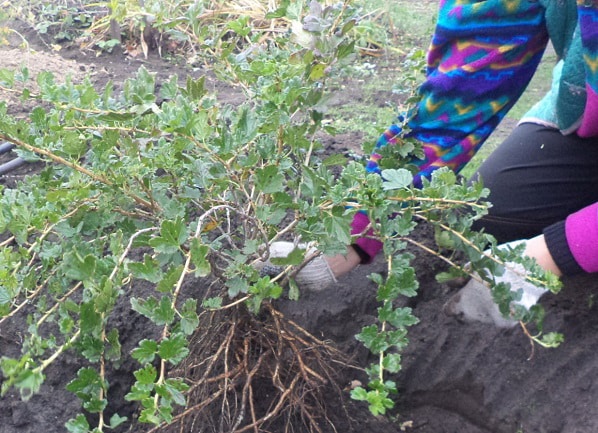How to replant gooseberries correctly
Ripe gooseberries are delicious both fresh and in the form of sweet jams and marmalades. They are low in calories and loaded with essential nutrients. It is not difficult to grow this shrub yourself; one bush will provide you with a harvest of useful fruits for up to 15 years.
If a bad location was initially chosen when planting, or you decide to redevelop the garden, it becomes necessary to move the bush to a new location. Read our article about how and when you can transplant gooseberries to another place.
When is a transplant needed?

It is not always easy for a gardener, especially a beginner, to correctly plan the location of beds, shrubs and trees on the site. If an unsuccessful place was chosen when planting a crop, it is either uprooted or moved to a new place.
The reasons why there is a need to replant gooseberries often lie in poor choice of location. Gooseberries grow well and bear fruit in an open, sunny space, protected from the cold wind.
Important. In a damp place where groundwater lies close, and in an area with heavy clay soil, the bush begins to ache, and the berries grow small and unsweetened.
If moving was required in order to free up space on the site, then it is convenient to place the bushes along the fence, at a distance of a meter from it, or near young trees, leaving a free distance of at least 2 m.
Replanting is required if several bushes planted nearby have grown and interfere with each other. In this case, the plant will not have enough light and nutrients. If the bushes are spreading, the optimal distance between them is 2 m.
In addition, moving to a new place helps to rejuvenate the bush. If the plant was originally planted in a well-lit place, but the berries are still small, it is moved to a new place for renewal.
Transplant timing
If you are thinking about moving any shrubs, the best time to do this is autumn or early spring, when the plants are dormant.
in autumn
When determining specific dates, the climatic conditions of the region are taken into account. The most favorable time for moving a bush is considered to be autumn. The time is chosen so that the plant has completed fruiting, but the cold has not yet set in.
Attention. If you transplant gooseberries in the summer, before fruiting is completed, the plant will not take root well. And if you delay replanting, the bush will not have time to take root in its new location before winter arrives.
The optimal time is the end of September - beginning of October. By this time, the bush has time to free itself from foliage and berries, and vegetative processes slow down. At this time, the root system is most prepared for transplantation. To move, choose a cool, cloudy day, then the plant will not lose much moisture and will take root well.
in spring
The shrub is unpretentious and recovers early from the winter cold. The buds bloom already in April and the plant begins to prepare for flowering and fruiting. Therefore, spring transplantation is carried out until the beginning of April, until the buds swell.
Advice. Before transplanting gooseberries to a new place in the spring, make sure that the buds have not yet begun to swell. Otherwise, the bush will not take root well in its new location.
If the buds have already begun to swell, then it is not recommended to injure the root system; it is better to postpone replanting until the fall.
Moving Instructions

Moving gooseberry bushes begins with selecting and preparing a new area where the plant will feel comfortable.
Choosing a new place
When choosing a new site, the following factors are taken into account:
- Illumination. A sufficient amount of sunlight guarantees the sweetness of the fruit and the health of the plant.
- Wind protection. Gooseberries love places protected from cold winds, so they grow well along fences and walls of outbuildings.
- Soil composition. Gooseberries bear fruit best in loamy soil. If the soil is heavy, add sand before planting; if it is acidic, add lime.
- Humidity. The plant is not planted in wetlands with excess moisture. Excess water leads to the development of fungal diseases (for example, powdery mildew) and rotting of the root system. Productivity decreases, and the berries become small and sour.
- Predecessors and neighbors. Gooseberries are planted after potatoes, legumes, and peas. It is not advisable to plant a bush where raspberries or currants used to grow, since these plants are only affected by pests. For the same reason, you should not choose a place next to currants or raspberries.
Transplant algorithm
To move the bushes you will need: ammonium sulfate and superphosphate fertilizer to enrich the soil, as well as tools (shovel, knife, pruning shears).
The transplant algorithm includes the following steps:
- A new plot is dug up with the addition of 100 g of ammonium sulfate and 50 g of superphosphate fertilizer for every 50 square meters of land. Fertilizer is mixed with the top layer of soil using a shovel.

- Planting holes are dug in the prepared soil slightly deeper than the root ball and twice as wide as it is. If you are planting several bushes, then place the holes at a distance of 1.5 - 2 m from each other.
- The ground around the base of the bush is dug up. Thick roots are cut with a sharp shovel. If the plant is large, a crowbar is used to remove it. They use it to pry up an earthen ball with a rhizome and shake the bush until it separates from the ground.
- The roots of the dug up bush are inspected. All dead and damaged roots are trimmed with a clean knife or pruning shears. The branches of the bush are cut by a third.
- The bush is installed in the hole. The top of the root ball should be 3-4 cm below the soil surface.
- The hole is half filled with soil and watered thoroughly with warm, settled water. Then fill the hole to the top and water again to moisten the soil and allow it to settle.
- The surface of the soil around the bush is mulched with a layer of 5 cm to retain moisture and prevent the growth of weeds.
Rejuvenation of an adult bush
Autumn replanting of gooseberries is an effective way to rejuvenate an old bush. In this case, before transferring to a new area, all thick and dry branches are removed from the bush. The remaining 6-7 young shoots are shortened by a third.
Then carefully examine the root system. Dried and damaged roots are cut off, leaving fibrous and well-developed roots. The old bush is replanted in the same way as the young one.
Transplantation of young shoots
In autumn it is also good to plant young gooseberry shoots. To obtain such shoots in the spring, annual shoots are pressed to the ground and dug in. In autumn, the shoot is separated from the bush and planted separately.
Before planting a young plant with poorly developed roots, they are treated with clay mash with the addition of stimulants. To prepare the solution, mix 3 liters of water, 1 kg of chernozem, 1 kg of clay, 6 g of the Aktara preparation and 1-2 sachets of Kornevin.
Read also:
An easy-to-care variety of gooseberry “Yarovaya”.
Care after transplant

After moving to a new location, the bush needs additional care. It consists of regular watering, fertilizing and weeding.
After replanting, make sure that the soil around the bush is constantly moist. If the soil is dry, water it after moving the mulch to the side. In this case, you should avoid waterlogging; it is enough to keep the soil moist.
If the new planting area was fertilized before replanting, then no additional fertilization is required. If not, then after planting the soil is fertilized with compost and organic fertilizers for active plant growth in the spring and good fruiting.
The transplanted gooseberries are freed from weeds by weeding the soil near the roots. This will provide the plant with optimal conditions for growth and development (sufficient sunlight and nutrients).
There is no need to cover gooseberry bushes for the winter. The plant is not whimsical and tolerates cold well. In spring, the transplanted shrub is treated against pests.
Read also:
How can you treat gooseberries to remove white plaque on the berries?
Powdery mildew on gooseberries: signs, causes.
Diseases and pests of gooseberries and methods of combating them.
Conclusion
Autumn is the optimal time to move a gooseberry bush to a new location. The summer season is over, fruiting is complete, which means that after replanting the plant will direct all its efforts to rooting and take root better. Properly organized transplantation of gooseberries in the fall helps them rejuvenate and increase fruiting.
During the replanting process, special attention is paid to choosing a new location (well-lit and not damp), preparing the soil and caring for the plant after moving.